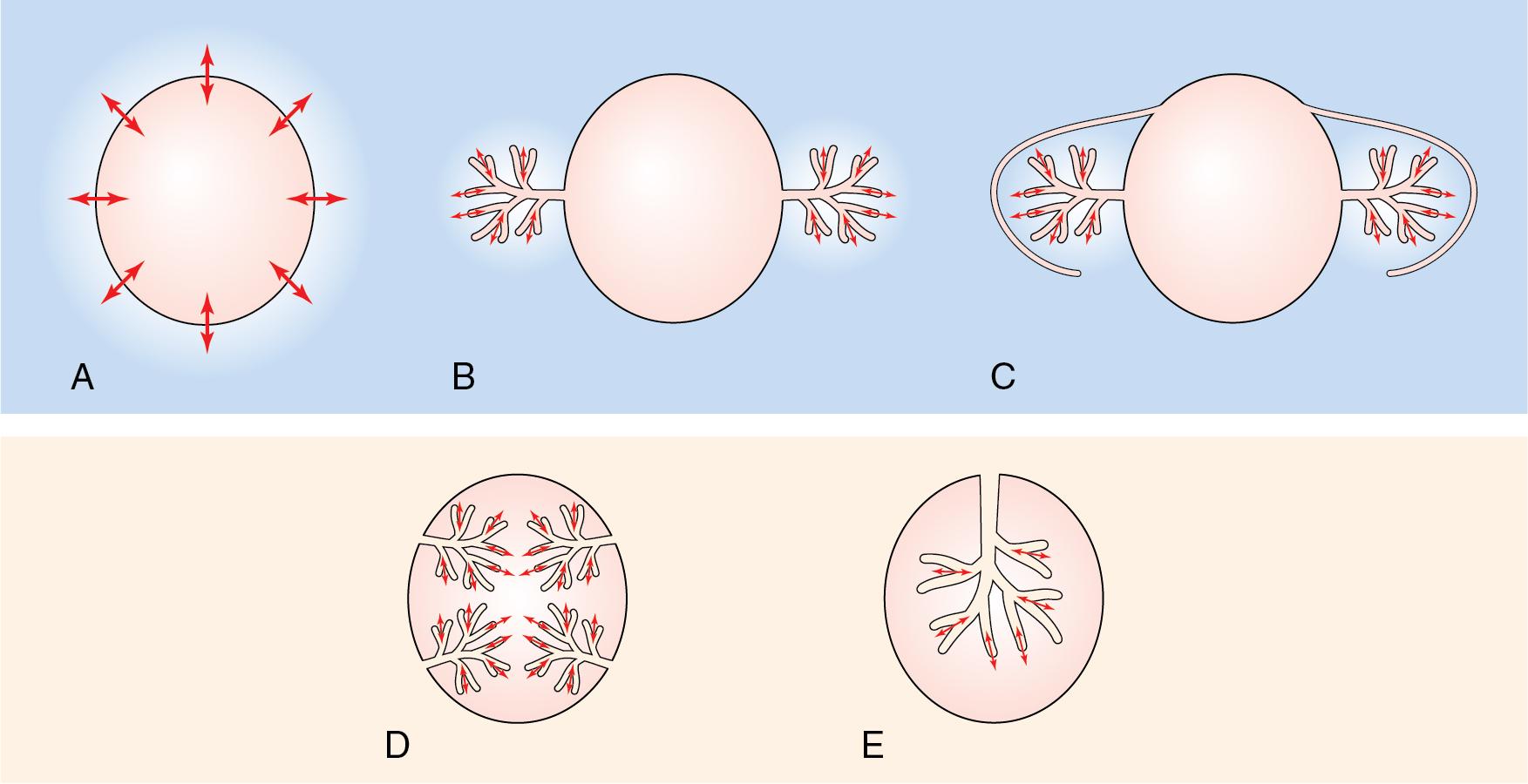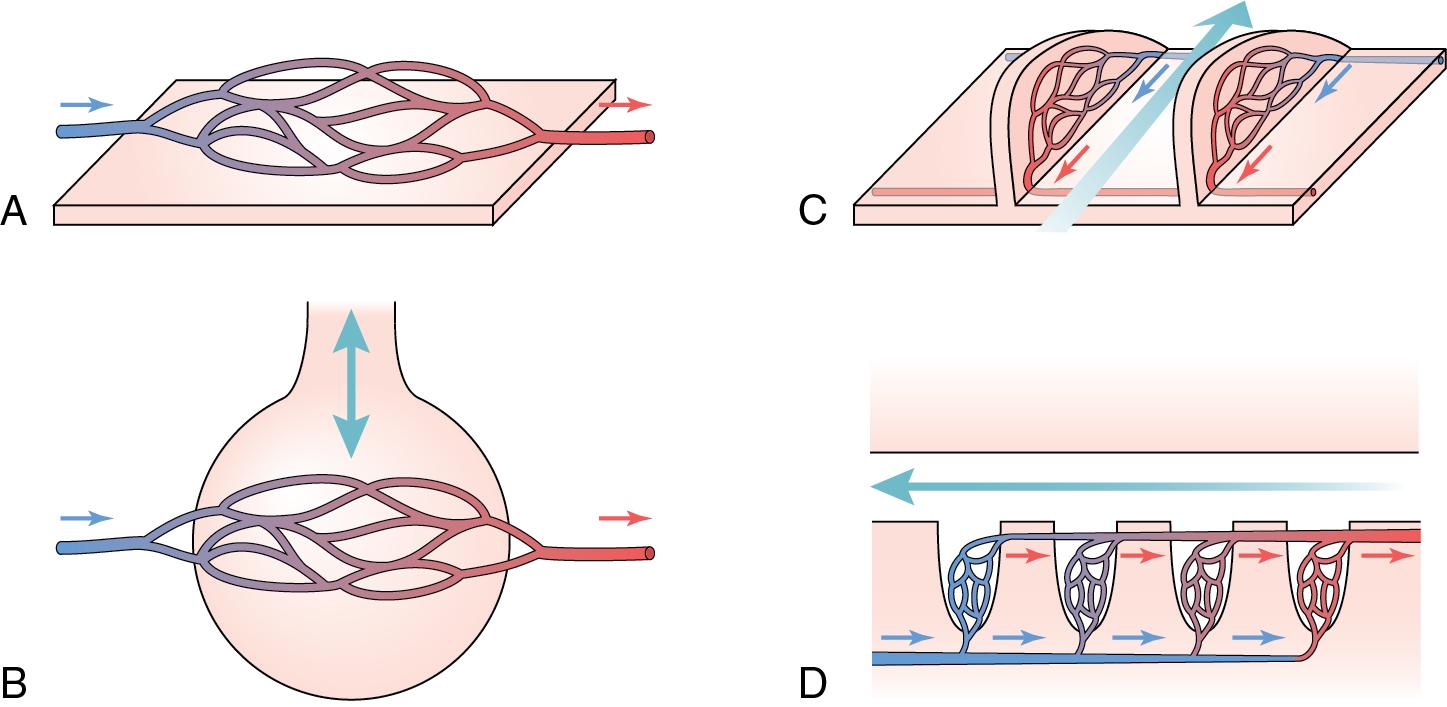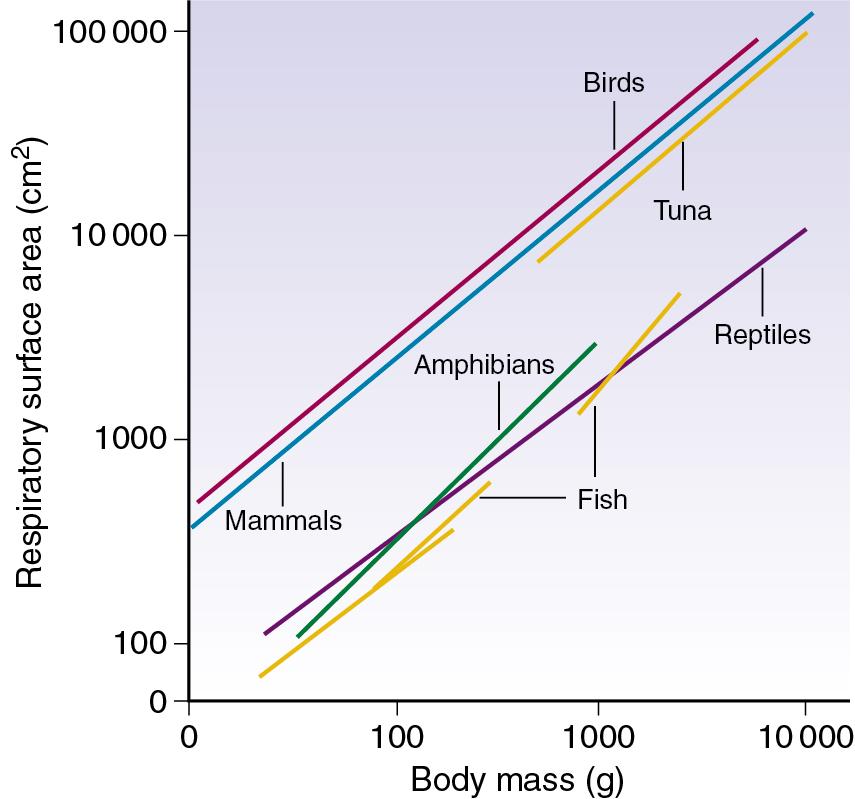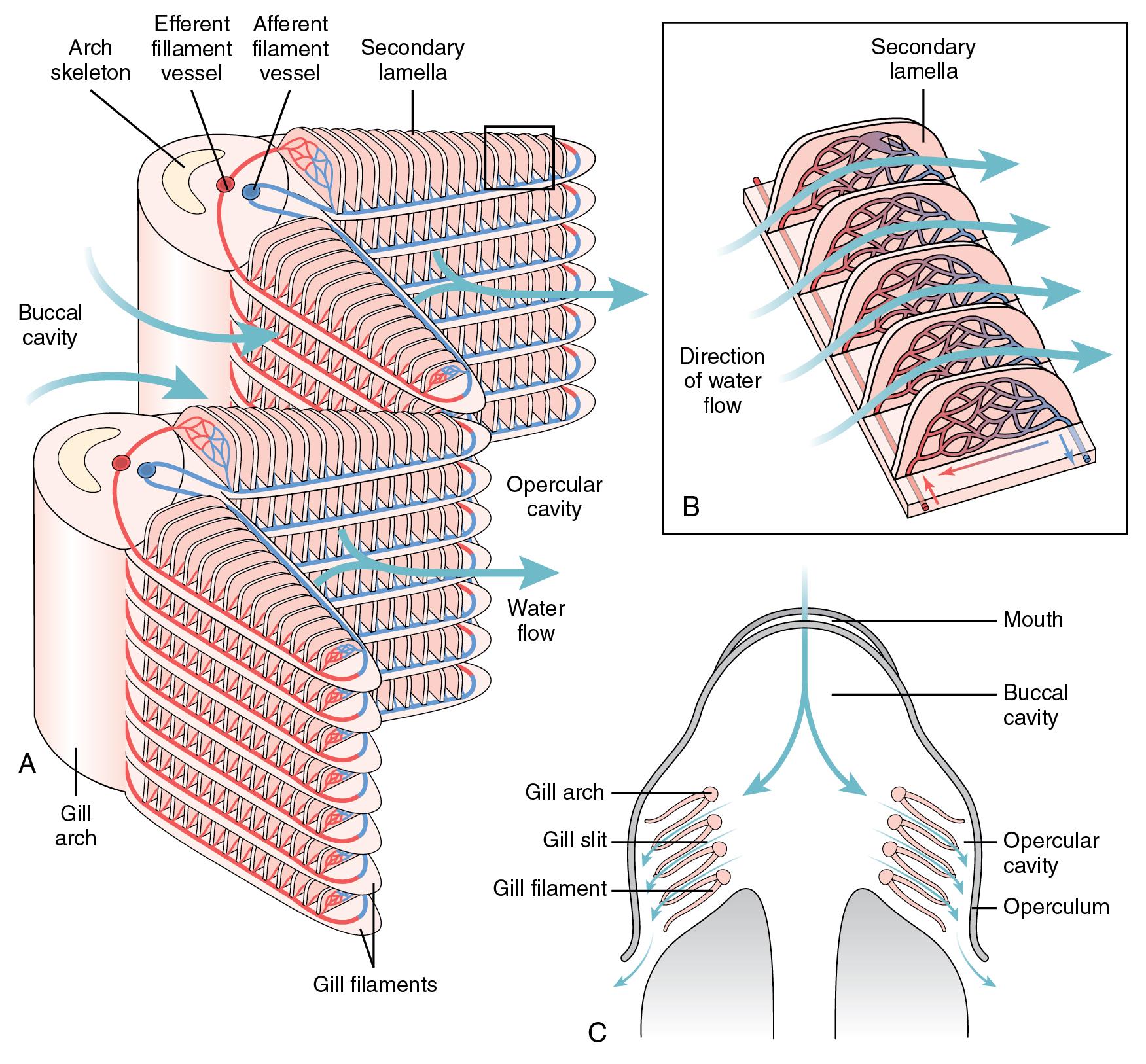Physical Address
304 North Cardinal St.
Dorchester Center, MA 02124
The animal kingdom contains a myriad of solutions to the challenge of respiratory gas exchange, such as integument respiration, external or internal gills in water or a tracheae system or lung for breathing air.
Factors affecting respiratory system design include the breathing medium (water or air), body temperature and activity level (metabolic rate), with homeothermic (warm-blooded) animals requiring more efficient systems and air to breathe to obtain sufficient oxygen.
Circulatory systems for gas transport vary, from ‘open’ systems containing haemolymph in primitive animals, to single circulations in fish with gills and other organs in series, to the dual circulation for the lungs and body of homeotherms.
There are only three types of oxygen-binding molecule in the entire animal kingdom, all based on a metal atom bound to a protein, with the familiar haemoglobin being the most common, although this exists in many different functional forms.
Mammals have adapted to extreme environments that challenge respiration to its limits, such as living in underground burrows, at high altitude and in the marine environment where spectacular depths and durations of dive can be tolerated.
Thoroughbred horses have been selectively bred to exercise efficiently and can generate almost double the exercise capacity of a human, although the adaptations to allow this also make them more vulnerable to some lung diseases such as exercise-induced pulmonary haemorrhage.
Until now this book has only considered respiration in a single species. Elsewhere in the animal kingdom there is wide variation in respiratory system design to accommodate the varying environments and lifestyles of the millions of different species. This chapter provides the briefest of outlines of these different systems in the major phyla of the animal kingdom ( Table 26.1 ). The respiratory system that has evolved in humans works well enough for us, but compared with many other animals its design flaws and limitations become apparent, and the examples in this chapter of extreme physiological adaptations in animals illustrate this. Conversely, some animals have significant limitations placed on them by their respiratory systems, so the pathophysiologies of common respiratory conditions in veterinary practice are also described.
| Phylum | Class | Examples | Gas Exchange | Respiratory Circulation | Oxygen Carrier |
| Annelida | Segmented worms | Earthworm | Diffusion across integument | Closed circulation, multiple hearts, subcutaneous capillaries for gas exchange | Monomeric Hb, both intracellular and extracellular |
| Arthropoda | Chelicerata | Spiders, horseshoe crabs | Tracheae and book lungs | Open circulation, multiple hearts, no role in respiratory gas transport | Extracellular Hb or Hc in haemolymph |
| Myriapoda | Centipedes, millipedes | Tracheae | Open circulation, multiple hearts, no role in respiratory gas transport | Extracellular Hc | |
| Crustacea | Shrimp, lobster, crabs | Internal gills, located in branchial chambers above each leg | Open circulation, some valve systems to direct flow into a circular pattern | Extracellular Hc | |
| Hexapoda | Insects | Tracheae | Open circulation, multiple hearts, no role in respiratory gas transport | None (Hb in larval stage) | |
| Brachiopoda | Articulata | Lamp shells | Diffusion across mantle surface | Open circulation | Hc in pink blood cells in coelomic fluid |
| Chordata | Amphibia | Frogs, salamanders | Multimodal: gills as larvae, lungs and skin as adults | Dual system, two atria and single ventricle | Hb as trimers (deoxygenated) or tetramers (oxygenated) |
| Reptilia | Reptiles | Primitive lungs | Dual system, variable heart structure with three or four chambers | Tetrameric Hb | |
| Aves | Birds | — | Dual system, four-chamber heart | Tetrameric Hb | |
| Mammalia | Mammals | — | Dual system, four-chamber heart | Tetrameric Hb | |
| Chondrichthyes | Cartilaginous fish, e.g., sharks | Gills | Single circulation, with gills and body tissues in series | Monomeric Hb in jawless fish; tetrameric in others | |
| Osteichthyes | Bony fish | Gills | Single circulation, with gills and body tissues in series | Tetrameric Hb | |
| Cnidaria | Jellyfish, anemones | Diffusion, metabolically active cells on the body surface | None | None | |
| Echinodermata | Starfish, sea urchins | Diffusion across integumental papullae | Water vascular system | Dimeric Hb (deoxygenated), tetrameric Hb (oxygenated) | |
| Mollusca | Gastropoda | Slugs, snails | Diffusion, via integument or air-containing mantle chamber | Open circulation | Hc |
| Cephalopoda | Octopus, squid | Internal gills, water flow generated by locomotion or currents | Closed circulation, one main heart and multiple ‘gill hearts’ | Hc | |
| Bivalvia | Clams, oysters, mussels | Internal gills, water flow generated by cilia | Open circulation | Tetrameric or dimeric Hb (some species = Hc) | |
| Platyhelminthes | Flatworms | Diffusion | None | None | |
| Porifera | Sponges | Diffusion, facilitated by water flow through an atrium generated by flagella | None | None |
The primary function of a respiratory system is the transport of oxygen and carbon dioxide to and from their point of use and production in cells. There are three ways by which gas molecules may be moved:
Diffusion. This has been considered in detail in Chapter 8 , and describes the movement of gas from an area with a high partial pressure to an area with a lower partial pressure, with the rate affected by molecular size and temperature. Diffusion of gases dissolved in liquids is further complicated by its solubility in the liquid (page 112) and is significantly slower than its diffusion within a gas mixture. For example, at 20°C oxygen in water diffuses 200 000 times slower than oxygen in air.
Mass movement . This can occur in gases or liquids. In gas mixtures mass movement describes movement of gas in response to a total pressure difference, for example, tidal ventilation into lungs or movement of air into an insect’s tracheal system during flying. In liquids, mass movement of the liquid in which the gas is dissolved can occur, for example, when oxygen-containing water flows through the gills of fish.
Facilitated mass movement . This describes a system in which liquid is altered to improve its gas-carrying capacity, for example, by the addition of a molecule such as haemoglobin (Hb) to improve carriage of both oxygen and carbon dioxide.
These are illustrated in Figure 26.1 and may be classified as follows:
Integument respiration. Gas exchange by diffusion across the animal’s body surface is feasible on a small scale and is normally the only method available to single-cell organisms. For diffusion alone to support respiration the organism must either live in water or have a wet surface in which the gases can dissolve before diffusing across the cell wall. Many larger and more complex animals, for example, amphibians, use integument respiration as an adjunct to other gas-exchange strategies.
External gills. Gills are organs of gas exchange in aquatic animals. The simplest design is for gills to protrude out of the body into the surrounding water. The gas-exchange surface area is normally maximized by a branching structure of the gills, which may simply contain cytoplasm or fluid or, in more complex animals, blood vessels. For efficient exchange of gases across gills the diffusion barrier needs to be as thin as possible, thus external gills are inevitably fragile structures and prone to damage from the animal’s environment.
Internal gills. For larger animals in which external gills are impractical, the gills are covered by a protective structure usually referred to as an operculum. With this protection the gills can be larger and structurally better designed to maximize gas exchange.
Tracheal system. Insects use a system of body cavity tubes into which air diffuses directly to the tissues. This is an efficient system except for the size limitations described later.
Lungs. A lung refers to an internal structure into which air is transported by mass movement to allow gas exchange. Because air has lower viscosity and contains more oxygen than water, mass transport for respiration is easier, thus air breathing allows a smaller gas-exchange area to support a greater metabolic demand. Gas flow in the lungs of most species is tidal in nature, but in some animals, such as birds, gas flow through the lungs may be almost continuous. A drawback of lungs is the requirement to keep the gas-exchange surface wet to allow diffusion to occur, a problem that has been solved by internalization of the lungs.

For more complex animals that have a circulatory system, an important design consideration is the way in which the air or water in the external environment comes into contact with the blood ( Fig. 26.2 ). In its simplest form, diffusion across the body surface should be sufficient because the blood is exposed to the ambient gas partial pressures, but the diffusion barrier of the integument is inevitably large compared with more specialized gas-exchange organs. In animals with tidal breathing (including humans) the carbon dioxide leaving the circulation mixes with the oxygen entering the lung ( Fig. 26.2 , B ), resulting in the alveolar partial pressures of both gases being intermediate between values in blood and inspired gas. As a result, the partial pressure difference driving gas diffusion between blood and lung is lower than the difference between inspired gas and blood. A countercurrent system of gas exchange is much more efficient. If the flow of blood through the lung or gill capillaries is in the opposite direction to the flow of gas or water, then exchange of respiratory gases will be maximized, and can, in theory at least, result in partial pressures of carbon dioxide and oxygen in blood leaving the lung or gill almost equal to those in the air or water being breathed. There will always be some difference because of the diffusion barrier across the lung/gill membrane, but a countercurrent arrangement will always be more efficient than tidal breathing. Finally, in a cross-current design, seen in bird lungs, the anatomical arrangement of the air and blood passages is similar to a countercurrent system. Air flows through the parabronchus in the opposite direction to lung blood flow, and capillaries cross the air capillaries throughout the length of the parabronchus ( Fig. 26.2 , D ). Thus the first capillaries become better oxygenated than the later ones as the oxygen level in the parabronchus falls.

Availability of oxygen in the surrounding medium is highly variable between different environments, as shown in Table 26.2 . It can be seen that air breathing is very advantageous for oxygen availability, with oxygen more abundant even at very high altitude compared with in water. Apart from altitude, other environmental factors may affect the constituents of the respiratory medium, for example, in burrowing mammals. The subterranean existence of the blind mole rat exposes it to significantly hypoxic and hypercapnic atmospheres (measured minimum oxygen 6.1% and maximum carbon dioxide 7.2%). These highly active small mammals have developed a range of adaptations to thrive in this environment, including altered ventilatory responses to hypoxia and hypercapnia, larger pulmonary-diffusing capacity for oxygen and greater capillary density in muscles.
| Medium | Available Oxygen (mL.L −1 , Sea-Level Equivalent) |
| Air: sea level | 209.4 |
| 3050 m (10 000 ft) altitude | 144.0 |
| 6100 m (20 000 ft) altitude | 66.1 |
| Freshwater 3°C | 9.4 |
| 10°C | 7.9 |
| 20°C | 6.4 |
| 30°C | 5.3 |
| Seawater 3°C | 7.4 |
| 10°C | 6.3 |
| 20°C | 5.2 |
| 30°C | 4.4 |
For aquatic animals the situation is even more challenging, with the oxygen content varying widely according to the temperature, salinity, depth and mixing of the water. Furthermore, the quantity of oxygen-consuming biomass in the environment has a profound effect, and if high can render water almost totally anoxic. As a result, large areas of the Earth’s oceans are mostly hypoxic, and sewage from humans and other animals on land is rendering many coastal areas more hypoxic than ever because of the increasing numbers of bacteria in the water. Fish are therefore better adapted to survive in hypoxic conditions than most air-breathing animals.
A majority of the kingdom Animalia are ectotherms, that is their body temperature is determined mostly by their environment, although ectotherms can still control their temperature by, for example, basking in the sun. Ectotherm heat production is insignificant, and their metabolic activity, and therefore respiratory requirement, is low. Only mammals and birds are homeotherms, in which endogenous metabolic heat production allows a tightly controlled constant body temperature to be maintained. The energy required to achieve this and the respiratory requirement are very high. Homeotherms therefore have all developed complex respiratory systems based on air-breathing lungs and a dual circulation.
For homeotherms environmental temperature will affect the respiratory requirement for heat generation. A more significant effect for both endotherms and ectotherms is their activity level. For example, flying animals such as some birds and insects have significantly higher energy requirements than similar-sized members of other phyla.
Whatever design of respiratory system is used, gas exchange ultimately depends on diffusion of gases across a tissue. Estimates of gas-exchange surface area in either lungs or gills relative to body size produce generally linear relationships within groups of similar species ( Fig. 26.3 ). Homeotherms, with their greater respiratory requirements, tend to require more gas-exchange area than ectotherms. An exception to this rule is the many species of tuna, all of which are very active fish. They have adapted to become partly endothermic and are able to increase the temperature of some parts of their body, such as the muscles, to improve metabolic rate and thus appear similar to endotherms, as seen in Figure 26.3 .

The design of respiratory systems for different groups of animals may be divided into those predominantly evolved for existing in water, air or both. However, as can be seen from the following examples, these divisions are blurred, with many examples of animals adapting one system to function perfectly well in a different environment; notable examples are land crabs and lung fish.
Single-cell organisms of other kingdoms can all respire adequately by diffusion. A ciliated surface and locomotion through the water reduces the boundary layer where oxygen levels are low around the organism, and internal movement (‘stirring’) of the cytoplasm produces mass movement of respiratory gases. Theoretical calculations suggest that the maximum distance oxygen can diffuse in biological media is 0.9 mm. For small animals diffusion respiration works well enough, for example, in fish larvae before their gills have developed, although it does make entire populations of larvae susceptible to hypoxia and death if the P o 2 of the water falls.
Larger animals can use diffusion respiration by changing their body shapes, for example. small aquatic worms can be sustained by diffusion alone either by flattening the body (e.g., flatworms) or by undulating the body to increase gas exchange. In more complex animals a circulation is required which takes blood to the body surface where diffusion respiration occurs.
Much larger aquatic animals have adapted to use diffusion respiration by a variety of techniques. All Porifera species (sponges) rely solely on diffusion, and in the larger animals this is done by either pumping water through an atrium inside their body, usually using flagella, or by living in areas where natural water currents exist to prevent the formation of a hypoxic boundary layer. A further strategy to maximize diffusion respiration is illustrated by Cnidaria (e.g., jellyfish) in which all the metabolically active cells are on the animal’s surface. The internal structure, furthest away from the source of oxygen, consists of mostly structural proteins such as form the jelly and which have no metabolic requirement for oxygen.
Echinodermata (e.g., starfish, sea urchins) have an internal fluid-filled coelomic cavity within their body connected to an extensive ‘water vascular system’ around which water is circulated by cilia. As an example, in a starfish the water vascular system communicates with numerous branchial papulae on the animal’s surface and the tube feet underneath, both of which are thin-walled structures that allow diffusion of gases between the coelomic fluid and the ambient water, thus functioning as numerous small external gills. The water vascular system extends up each of the five tentacles and communicates in the centre of the animal, allowing distribution of oxygenated fluid around the whole body, particularly when the animal is moving and oxygen requirement increased.
This large seawater-dwelling phylum is characterized by the presence of a mantle, or seawater-filled body cavity, within their structure. Depending on the species, the mantle contains varying numbers of gills, which are protected from the environment by the mollusc’s body or shell. Water flow through the mantle in most classes is achieved by beating cilia, which generate water flow in the opposite direction to gill blood flow to establish a countercurrent system. In many molluscs the gill structure is in the form of sheets, with pores between adjacent layers through which cilia propel the water, thus maximizing both surface area and contact with the water. In Cephalopoda (e.g., squid, octopus), the mantle has no cilia, and water flow is generated by swimming or by external water currents.
The Gastropoda class of molluscs are land-dwelling animals (e.g., slugs, snails), and depend mostly on diffusion respiration, requiring them to live in moist habitats. Some specialized gastropods, also referred to as ‘pulmonates’, have developed an air-filled mantle cavity, normally within their shell. They have no gills, but a highly vascular mantle lining (a primitive lung) which supplements integumental respiration, particularly when body movements provide some mass movement of air into the mantle cavity.
Decapod crustaceans (e.g., crabs, shrimps, lobsters), so named because of their five pairs of legs on the thorax, are characterized by a sheet of exoskeleton covering their thorax and head called a carapace. Developmentally their gills originate with their legs and lie in the water-filled spaces between the carapace and their thorax skeleton, each occupying a single branchial chamber. Water is driven through the chambers by scaphognathites, or gill bailers, which beat rhythmically and rapidly to propel water across the gills, again in a unidirectional pattern, generating a countercurrent system with gill blood flow. In land-dwelling crabs, the same anatomical structure is retained, and the branchial chambers are ventilated in the same way but with air. Because of the high oxygen content of air compared with water (see Table 26.2 ), land crabs have evolved smaller gills than their aquatic relatives, and their enlarged branchial chambers have developed vascularized linings that contribute to respiratory gas exchange.
Gills in fish are arranged as a series of cartilaginous gill arches, each of which has two rows of gill filaments forming a corrugated structure through which the water flows ( Fig. 26.4 ). Each gill filament has numerous secondary lamellae (approximately 40 per mm) protruding perpendicularly from both sides, through which blood flows in the opposite direction to the flow of water ( Fig. 26.4 , C ) establishing a countercurrent system.

Gas-exchange efficiency is therefore dependent on the rate at which water flows across the gills, and different species have developed a wide range of strategies to control this. Buccal-opercular pumping is the most common ( Fig. 26.4 , C ), in which the entrances to the mouth and operculum are opened and closed alternately, and the muscular walls of the cavities used to pump water across the gills. Pumping may result from generating a positive pressure in the buccal cavity, negative pressure in the opercular cavity or both, and commonly results in continuous water flow. For even greater water flow, fish may adopt ‘ram’ ventilation in which they swim forwards with both the mouth and opercular cavities open and rely on their forward movement to push water across the gills. For some particularly active species, such as tuna, ram ventilation is obligatory. This also results in an automated control of oxygen uptake during exercise—the faster the fish swims, the more energy and oxygen are required, which is automatically provided by the increased water flow across the gills and associated increased rate of oxygen uptake.
Gills in most aquatic animals, including fish, have many other functions apart from gas exchange, and may include feeding, excretion of water-soluble waste, acid–base balance and control of body electrolytes. As a result, the blood–gas barrier of a gill is often thicker than in a lung, , most commonly because of the required ion-exchange functions and also from the requirement for more structural cells (pillar cells) to prevent gill collapse ( Fig. 25.5 ). This dual function of gills gives rise to the term ‘osmorespiratory compromise’. In freshwater fish, the gills are required to actively absorb electrolytes from the water flowing through the gills, whereas in seawater fish the gills need to excrete the excess electrolytes absorbed into the body from the surrounding hypertonic environment.
As previously described, an aquatic environment means more frequent exposure to hypoxic conditions, and fish are well-adapted to this challenge. Gulping air and skimming the oxygen-rich water near the surface are behavioural methods for improving acute hypoxia. Gills contain oxygen-sensitive neuroepithelial cells that closely resemble the glomus cells in mammals (page 50), and when stimulated have a similar effect, inducing hyperventilation of the gills. Finally, if hypoxia lasts a few days, in some species gill cellular morphology can change, increasing the gas-exchange surface area.
Air-breathing fish are a reminder of the evolutionary path from which land animals developed. Gas exchange may occur either through the well-perfused walls of gas bladders or in more specialized structures, regarded as primitive lungs, although the distinction between these is rather arbitrary. Of extant species the lungfish, as the name suggests, has the most structurally advanced gas-exchange system, with its lungs containing complex ridges of cartilaginous parenchyma covered in respiratory epithelium which closely resembles the alveolar epithelium of mammals (page 10).
Amphibians are the next evolutionary step away from water for vertebrates. Most species begin life as larvae in water and metamorphose into animals able to live in either air or water. They are an excellent example of multimodal respiration, using gills as larvae, progressing to both lung and integument (skin) respiration as adults. Amphibian larval gills may be external (salamanders) or internal in the order Anura (frogs and toads). Adult amphibian lungs are primitive compared with mammals: salamanders, which rely heavily on skin gas exchange, may have no lungs at all, or simple air-filled sacs. In Anura species the lungs are more developed, with the lining containing multiple folds giving a honeycomb structure. Ventilation in air is by a buccal pump mechanism in which the floor of the mouth repeatedly pushes air into the lung under positive pressure; expiration is mostly passive. In amphibians the lungs are effectively an organ predominantly for oxygen uptake, with carbon dioxide excretion occurring mostly via the skin. When hibernating in cold water frogs depend purely on skin respiration for long periods of time, facilitated by their very low oxygen requirement at low temperatures.
Become a Clinical Tree membership for Full access and enjoy Unlimited articles
If you are a member. Log in here